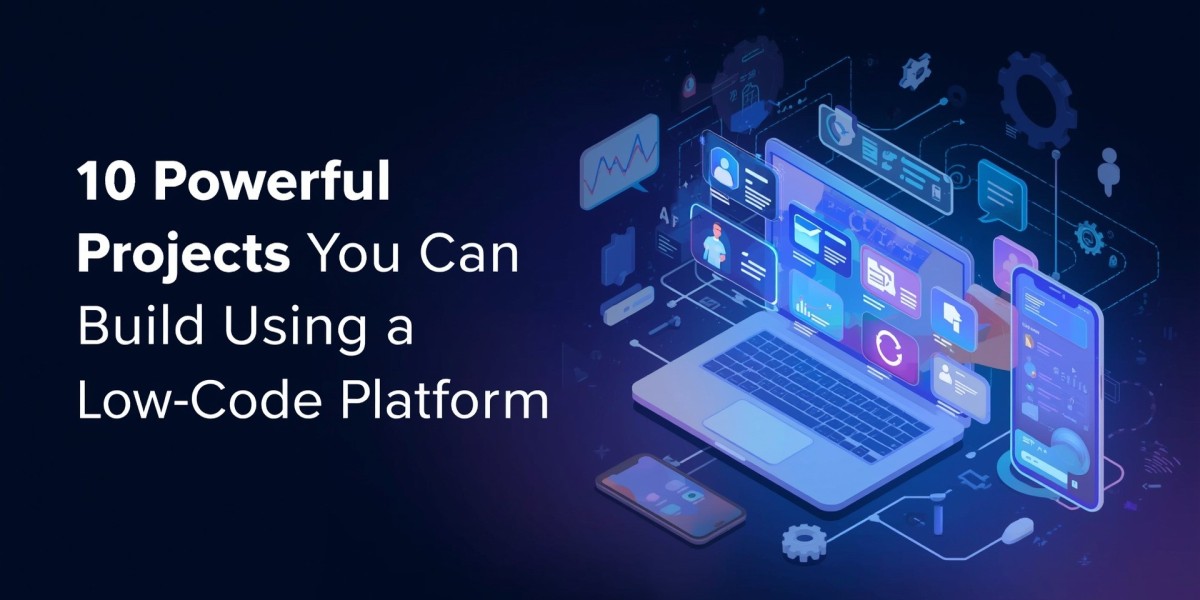
Building brilliant apps shouldn’t be reserved for expert coders. Whether you’re a visionary startup founder, an ambitious solo entrepreneur, a small business owner, or simply someone bursting with ideas — the power to create is now in your hands, no coding degree required.
Thanks to low code platforms, you can bring your ideas to life — fast. These intuitive tools empower anyone to design apps, websites, workflows, and automation solutions with minimal programming, cutting both cost and complexity. From concept to launch, it’s all about speed, simplicity, and creativity.
In this blog, we’re diving into 10 powerful projects you can build using a low code platform, along with a spotlight on FAB Studio — an innovative application development platform that’s helping creators, businesses, and developers build smarter, faster, and better than ever.
What is a Low Code Platform?
A low code platform is a visual software development environment that allows users to create applications through graphical user interfaces and pre-built templates instead of traditional hand-coded programming. These platforms are equipped with drag-and-drop builders, pre-set logic, and automated code generation tools to speed up the development lifecycle.
While no-code tools are designed for users with zero coding knowledge, low code platforms offer more flexibility — allowing both technical and non-technical users to collaborate, build, and deploy scalable solutions.
10 Powerful Projects You Can Build Using a Low Code Platform
Let’s dive into the most impactful and practical projects you can build using a low code platform today:
1. Custom Business Dashboards
One of the most common and useful applications of low code platforms is creating custom dashboards. Whether you’re tracking sales, customer engagement, or employee performance, a low code dashboard can help you visualize real-time data from different sources.
You can integrate databases, Excel sheets, CRMs, or APIs into one clean interface and allow your team to make informed decisions. Many app builder tools offer built-in data widgets and charts that are customizable without writing a single line of code.
2. E-Commerce Stores
Gone are the days when you needed a developer to launch an online store. Using web builder capabilities in a low code platform, you can build a fully functional e-commerce site in a matter of hours. Choose from templates, add product listings, manage inventory, and even integrate payment gateways like Stripe or Razorpay — all with minimal effort.
Plus, the mobile responsiveness and SEO-friendly features ensure your store is ready for customers on any device.
3. Internal Tools and Employee Portals
Companies often need internal systems like leave trackers, task managers, and document submission forms. These tools, while simple in nature, usually take weeks to build through traditional methods.
With low code, you can create secure internal portals with role-based access control. From employee onboarding to IT support request systems, these internal tools can be customized on the go, without involving a whole development team.
4. Customer Feedback and Survey Apps
Understanding your customers is critical for business success. With a low code platform, you can build customer feedback systems or survey apps quickly. These applications can be integrated with your CRM or email marketing tools to collect insights in real-time.
You can even use code builder tools to trigger workflows based on responses, such as sending personalized emails or assigning customer queries to the right department.
5. Automated Lead Generation Funnels
Want to capture leads from social media or ads and automatically push them into your CRM? A low code platform can help you design an automated funnel where a user lands on a page, fills in a form, and the data gets sent to your sales team or email list instantly.
This eliminates the need for third-party integrations and expensive automation tools — everything is built right inside your app builder.
6. Mobile Apps for Events or Communities
Organizing an event, a conference, or even a local community group? Instead of hiring an expensive mobile app developer, use a low code app builder to create a native or hybrid app.
Add features like RSVP, push notifications, schedules, location maps, and live updates — all using pre-configured blocks. With an AI code generator built into some platforms, you can even customize functions that make your app unique.
7. Customer Support Chatbots and Ticketing Systems
Customer service is evolving, and automated support systems are the future. Using a low code development environment, you can create simple or advanced chatbots and integrate them with your website or app.
You can also build full ticketing systems where users can submit queries, track resolution progress, and receive updates — all through a centralized dashboard.
8. Blog or Content Publishing Platforms
Writers, marketers, and educators can easily build their own content platforms using web builder tools. Whether it’s a blog, tutorial site, or a full-fledged content hub with categories and search functionality, a low code platform offers you the foundation to go live fast.
You can also include newsletter signups, user registration, and comments without any complex backend setup.
9. Finance and Budget Management Tools
Budget planners, expense trackers, or invoice generators — these are tools that many businesses or individuals need. With a code generator system in low code tools, you can build financial apps with real-time data sync and calculations.
Such tools can pull in data from banks or spreadsheets and present it through intuitive interfaces. Alerts, summaries, and trend analysis dashboards can also be added easily.
10. Learning Management Systems (LMS)
Want to launch your own online course platform? Whether you’re a coach, teacher, or corporate trainer, you can use a low code platform to create an LMS without complex coding.
Features like video hosting, quizzes, assignments, certificates, and user progress tracking can be implemented using drag-and-drop builders or AI-generated code.
FAB Builder — A Game Changer in the Low Code Space
Among the many platforms offering low code development capabilities, FAB Builder stands out with its modern and developer-friendly features.
FAB Studio, the core engine behind FAB Builder, is a flexible and scalable low code platform designed to bridge the gap between simplicity and customization. It combines the best of both worlds — visual app building for non-coders and deeper control for technical users.
Here’s what makes FAB Builder different:
? Powerful Page Builder
FAB Builder comes with a modern page builder that lets you design responsive layouts with a drag-and-drop interface. You can structure complex pages, integrate media, and preview your work instantly — without switching tabs.
? Intelligent Code Generator
One of FAB Builder’s key strengths is its code generation engine. It automatically converts your visual designs into clean, maintainable code, helping developers extend and customize applications effortlessly.
This AI code generator significantly reduces development time while ensuring scalability.
? Full-stack App Support
Unlike other limited tools, FAB Builder enables full-stack application development. That means you can manage frontend, backend, and even databases — on a single platform. Whether you’re building a CRM, ERP, or inventory system, FAB Studio supports complex workflows and integrations.
? Developer + Business Friendly
FAB Builder isn’t just for designers or marketers. Developers can customize applications using advanced settings, while non-technical users can still build, iterate, and deploy solutions without writing code.
It’s a perfect collaboration tool for teams with varied technical backgrounds.
Why Use a Low Code Platform?
Using a low code platform brings multiple advantages:
- Faster time to market — Build apps in days, not months.
- Cost-effective — Reduce the need for large development teams.
- Greater flexibility — Iterate quickly based on user feedback.
- Empowerment — Allow marketers, analysts, and business owners to build tools without relying on developers.
- Integration ready — Most platforms support integrations with CRMs, payment gateways, Google Sheets, Slack, etc.
Conclusion
The rise of low code platforms is democratizing technology. Whether you’re solving a business problem, launching a startup, or just testing out a new idea — there’s never been a better time to build.
With powerful tools like FAB Builder, creating web and mobile applications is no longer restricted to those who know how to code. From landing pages to LMS platforms, and chatbots to business dashboards — the possibilities are endless.
If you’ve been sitting on an idea for too long thinking it’s too technical to bring to life, try a low code platform. You might just surprise yourself with how much you can build — without writing a single line of code.
Frequently Asked Questions (FAQ)
1. What is a low code platform?
A low code platform is a visual development tool that allows users to build applications quickly using drag-and-drop interfaces and minimal coding.
2. Can I build complex apps without coding knowledge?
Yes, with platforms like FAB Studio, you can build powerful web and mobile apps without deep coding skills using visual tools and AI-powered code generation.
3. Is FAB Builder suitable for both developers and non-developers?
Absolutely. FAB Builder is designed to support both technical and non-technical users, offering flexibility, ease of use, and customization options for everyone.








